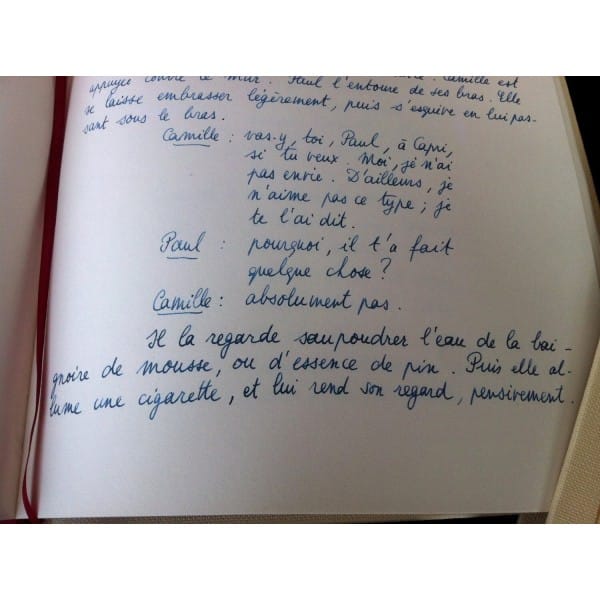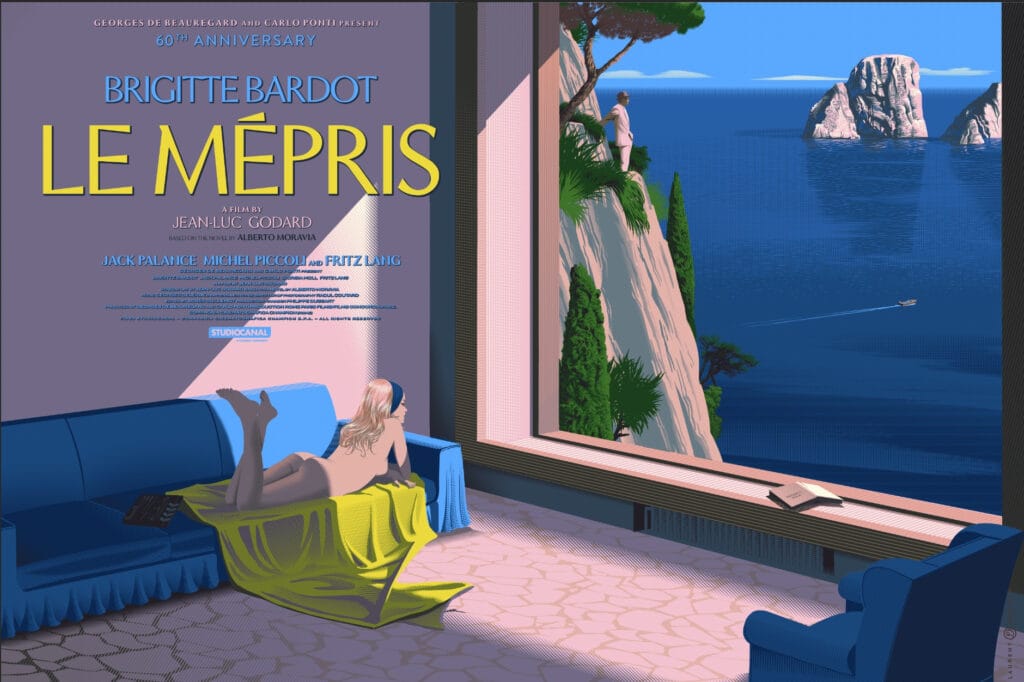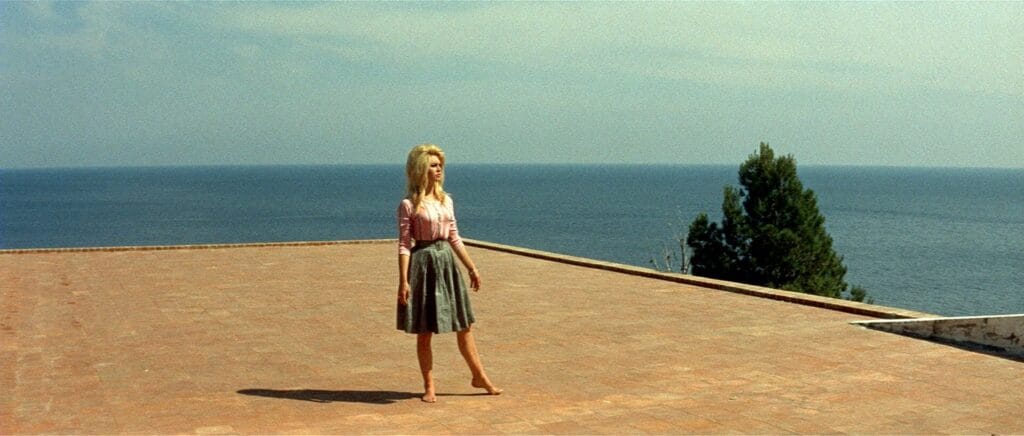Alberto Moravia’s Le Mépris (A Ghost at Noon in English) is a profound novel that delves into the complexities of human relationships, the nature of artistic integrity, and the existential struggles of modern life. Published in 1954, this book stands out for its thematic depth, precise narrative style, and psychological insight. Moravia, an influential Italian writer, uses the backdrop of a disintegrating marriage to explore broader issues of alienation, communication, and the search for meaning. The novel’s film adaptation by Jean-Luc Godard in 1963 further solidified its cultural significance, turning it into a rich dialogue between literature and cinema.

The Novel
The story of Le Mépris revolves around Riccardo Molteni, a screenwriter, and his wife, Emilia. Their relationship deteriorates as Riccardo becomes more engrossed in the film industry, particularly a project to adapt Homer’s Odyssey. Their love, once strong and passionate, starts to crumble under the weight of professional obligations, personal insecurities, and external influences. The novel intricately examines the emotional and psychological breakdown of their marriage against the glamorous yet superficial world of cinema.
Characters
- Riccardo Molteni: The protagonist and narrator, a screenwriter aspiring to be a playwright. Riccardo’s intellectual and artistic aspirations clash with the commercial demands of the film industry.
- Emilia Molteni: Riccardo’s wife, whose initial admiration for her husband turns into contempt. Emilia’s character represents the emotional and existential disconnect that can develop between partners.
- Battista: A wealthy film producer who embodies the commercial and often superficial nature of the film industry.
- Rheingold: The director of the Odyssey film, whose artistic vision and philosophical musings add another layer of complexity to the narrative.


Themes
Alienation and Isolation
A prominent theme in Le Mépris is alienation. The novel delves into the emotional and psychological distances that grow between individuals, even those who were once deeply connected. Riccardo and Emilia’s relationship exemplifies this theme. Despite living together and sharing the same life, they become estranged from each other. This estrangement is not just physical but also emotional and intellectual. Moravia uses their relationship to explore how modern life, with its pressures and distractions, can lead to profound feelings of isolation.
The Nature of Love and Contempt
The transition from love to contempt is central to the narrative. Riccardo’s idealization of Emilia and their love gradually gives way to a more complex and darker reality. Emilia’s contempt for Riccardo grows as she perceives him to be compromising his artistic integrity for commercial success. This shift in their relationship dynamics highlights the fragility of love and how easily it can turn into its opposite.
Artistic Integrity vs. Commercial Compromise
Riccardo’s struggle to maintain his artistic integrity in the face of commercial pressures is a critical aspect of the novel. His involvement in the film adaptation of the Odyssey serves as a metaphor for the compromises that artists often have to make. Moravia contrasts the lofty ideals of art with the often mundane and profit-driven world of filmmaking, raising questions about the true value of art and the sacrifices it demands.
Existential Questions and the Search for Meaning
Moravia’s novel is deeply existential, exploring questions of meaning, purpose, and identity. Riccardo’s journey is not just about his marriage or his career but also about his quest to understand his place in the world. The story delves into the existential angst that arises from the conflict between personal aspirations and external realities.
The Role of Cinema and Literature
Le Mépris also serves as a commentary on the relationship between cinema and literature. The adaptation of a literary classic like the Odyssey into a film symbolizes the intersection of these two forms of art. Moravia uses this to explore how stories are transformed and interpreted across different mediums, and what is gained or lost in the process.
Literary Style
Moravia’s writing is marked by its clarity, precision, and psychological depth. His narrative style is straightforward yet profound, effectively capturing the inner lives of his characters. The use of a first-person narrator allows readers to delve deeply into Riccardo’s thoughts and emotions, making the exploration of themes like alienation and existentialism even more impactful. Moravia’s prose is both analytical and poetic, providing a rich and immersive reading experience.

The Film Adaptation by Jean-Luc Godard
Background and Production
Jean-Luc Godard, one of the leading figures of the French New Wave, adapted Le Mépris into a film in 1963. Starring Brigitte Bardot, Michel Piccoli, Jack Palance, and Fritz Lang, the film is known for its stylistic innovation and thematic complexity. Godard’s adaptation, while staying true to the novel’s core themes, brings his unique cinematic vision to the story.
Plot Summary of the Film
The film follows a similar plot to the novel, with some variations to suit the cinematic medium. Paul Javal (played by Michel Piccoli), a French playwright, is hired to work on the screenplay for an adaptation of Homer’s Odyssey, produced by the American producer Jeremy Prokosch (Jack Palance) and directed by Fritz Lang, who plays himself. Paul’s relationship with his wife, Camille (Brigitte Bardot), deteriorates as he becomes more involved in the film project. The tension between artistic integrity and commercial interests, as well as the personal conflict between Paul and Camille, forms the crux of the film.





Themes in the Film
Godard’s Le Mépris retains the novel’s exploration of love, contempt, and artistic compromise but adds a layer of meta-commentary on cinema itself. The film is self-reflexive, with Godard using the medium to comment on the nature of filmmaking and the relationship between art and commerce.
Meta-Cinema and Reflexivity
Godard’s film is a meditation on cinema, with frequent references to film history and the filmmaking process. The presence of Fritz Lang as himself adds a meta-cinematic layer, blurring the lines between fiction and reality. This reflexivity is a hallmark of Godard’s style, inviting viewers to consider the nature of the film they are watching.

Visual Style and Aesthetics
The visual style of Le Mépris is notable for its use of color, composition, and location. The film was shot in Cinemascope, a wide-screen format that enhances the visual impact. The use of color, particularly the red, white, and blue motif, is symbolic and adds to the film’s thematic richness. The locations, including the famous Casa Malaparte on the island of Capri, contribute to the film’s aesthetic appeal and thematic depth.
Existentialism and Modernity
Like the novel, the film delves into existential questions and the search for meaning. Godard’s portrayal of Paul and Camille’s disintegrating relationship is imbued with a sense of existential dread and modern alienation. The film captures the malaise of modern life, with its emphasis on surface appearances and the erosion of deeper connections.
Differences from the Novel
While Godard’s adaptation is faithful to the spirit of Moravia’s novel, there are notable differences. The character names and some plot details are changed, and Godard’s focus on cinema as a theme is more pronounced. The film’s ending is also different from the novel, adding a tragic and ambiguous note that underscores the themes of loss and disillusionment.





Critical Reception and Legacy
The Novel
Le Mépris was well-received upon its publication and has since been regarded as one of Moravia’s masterpieces. Critics have praised its psychological depth, thematic complexity, and narrative precision. The novel’s exploration of the human condition, particularly the intricacies of love and alienation, continues to resonate with readers.
The Film
Godard’s Le Mépris is considered one of his greatest works and a landmark in film history. The film’s innovative style, thematic depth, and meta-cinematic elements have made it a subject of extensive critical analysis. It is often cited as a quintessential example of the French New Wave and a significant work in the study of cinema as an art form.
Influence on Literature and Cinema
Le Mépris has had a lasting impact on both literature and cinema. Moravia’s exploration of existential themes and human relationships influenced subsequent writers and filmmakers. The novel’s adaptation by Godard further cemented its influence, demonstrating the potential for rich, intertextual dialogues between literature and film. The story’s themes of love, alienation, and artistic integrity continue to inspire contemporary artists and thinkers.

Conclusion
Alberto Moravia’s Le Mépris is a seminal work that addresses timeless themes with psychological acuity and narrative finesse. Its exploration of love, alienation, and the struggle for artistic integrity makes it a profound commentary on the human condition. The novel’s adaptation by Jean-Luc Godard adds another layer of complexity, transforming it into a meditation on cinema and modernity. Together, the novel and film form a rich tapestry of artistic and existential inquiry, securing Le Mépris a prominent place in the history of literature and cinema.









